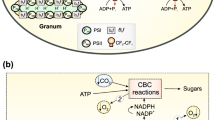Abstract
My perspective does not deal directly with photosynthesis research. However, the methods evolved have played an important role in several areas of biochemistry and biophysics including photosynthesis. Improvements of rapid reaction methods, based upon the pioneering studies of Hamilton Hartridge and F.J.W. Roughton, and Glenn Millikan, required a detailed study of the hydraulics of small-bore tubes and jet mixers, taking into account, that economy of reactants was demanded by the sparcity of enzyme preparations in the 1930s. This Personal perspective recites the steps taken to minimize the volumes expended in rapid flow studies, together with the improvements in electronic technology of rapid and sensitive spectrophotometry of labile intermediates in enzyme reactions. Of the methods studied, continuous, accelerated and stopped flow, the latter was designed for the highest fluid economy and subsequently proved to be of wide use for studying biochemical kinetics. Advances in fast spectrophotometry of dilute solutions led to great improvements in Millikan's dual-wavelength system, both in speed of recording and decreases of background noise level, largely due to electronic stabilization of light sources and sensitive amplifiers. The application of these technologies to studies of hemoglobin, myoglobin and heme enzymes was, more recently, followed by studies of suspensions of organelles, cells, and tissues not only in vivo but also at low temperatures with cryoprotectants, leading to the use of flash activation in carbon monoxide inhibited heme enzymes. Laser technology allowed photosynthetic systems to be studied at cryotemperatures, leading to the development of electron tunneling theories for biological reactions (not discussed in this paper). All in all, the many fundamental developments of electronics, optics and hydraulics indicate how technology can respond effectively to the needs of biology in general, and photobiology in particular.
Similar content being viewed by others
References
Chance B (1940a) The Accelerated Flow Method for Rapid Reactions. Dissertation in Chemistry, University of Pennsylvania, Philadelphia
Chance B (1940b) The accelerated flow method for rapid reactions. Part II. Design, Construction, and Tests. I. Apparatus Construction. J Franklin Inst 229: 737–766, (see p. 745)
Chance B (1940c) The accelerated flow apparatus for rapid reactions. Part I. Analysis. I. Introduction. J Franklin Inst 229: 455–476, (see p. 472)
Chance B (1940d) The accelerated flow method for rapid reactions. Part II. Design, Construction, and Tests. I. Apparatus Construction. J Franklin Inst 229: 737–766, (see p. 745)
Chance B (1942) Photoelectric colorimeter for rapid reactions. Rev Sci Instrum 13: 158–161
Chance B (1943a) The kinetics of the enzyme—substrate compound of peroxidase. J Biol Chem 151: 533–577, (see p. 569)
Chance B (1943b) The kinetics of the enzyme—substrate compound of peroxidase. J Biol Chem 151: 533–577, (see p. 558)
Chance B (1943c) The reaction of catalase and cyanide. J Biol Chem 179: 1299–1309
Chance B (1949a) The properties of the enzyme—substrate compounds of horse-radish and lacto-peroxidase. Science 109: 204–208
Chance B (1949b) The kinetics of the enzyme—substrate compound of peroxidase. J Biol Chem 151: 553–577
Chance B (1949c) The enzyme—substrate compounds of horse radish peroxidase and peroxides. II. Kinetics of formation and decomposition of the primary and secondary complexes. Arch Biochem 22: 224–252
Chance B (1951) Rapid and sensitive spectrophotometry. III. A double beam apparatus. Rev Sci Instrum 22: 619–638, (see p. 634)
Chance B (1994) Optical method. Ann Rev Biophys Biophysic Chem 20: 1–28
Chance B and Williams GR (1955) Respiratory enzymes in oxidative phosphorylation. II. Difference spectra. J Biol Chem 217: 395–407
Chance B, Brainerd JG, Cajori FA and Millikan GA (1940a) The kinetics of the enzyme—substrate compound of peroxidase and their relation to the Michaelis theory. Science 92: 455
Chance B, Harvey EN, Johnson F and Millikan GA (1940b) The kinetics of bioluminescent flashes. J Cell Comp Physiol 16: 195–215
Chance B, Greenstein DS, Higgins J and Yang CC (1952) Themechanism of catalase action. II. Electric analog computer studies. Arch Biochem Biophys 37: 322–339
Chance B, Holmes WF, Higgins J and Connelly CM (1958) Localisation of interaction sites in multicomponent systems: theorems derived from analogues. Nature 182: 1190–1193
DeSa R and Hastings JW (1968) The characterization of scintillons: bioluminescent particles from the marine dinoflagellate, Gonyaulax polyedra. J Gen Physiol 51: 105–122
Gibson QH, Kreuzer F, Meda E and Roughton FJW (1955) The kinetics of human haemoglobin in solution and in the red cell at 37 degrees C. J Physiol 129: 65–89
Haldane JBS (1930) Enzymes. Longmans, Green & Co., London
Hartridge H and Roughton FJW (1923a) The velocity with which carbon monoxide displaces oxygen from combination with haemoglobin. Part I. Proc Roy Soc Series B 94: 336–367
Hartridge H and Roughton FJW(1923b) A method of measuring the velocity of very rapid chemical reactions. Proc Roy Soc A 104: 376–394
Hartridge H and Roughton FJW (1923c) The kinetics of Haemoglobin. Part II. The velocity with which oxygen dissociates from its combination with haemoglobin. Proc Roy Soc A 104: 395–430
Johnson JB and Llewellyn FB (1934) Limits to amplification. Trans AIEE 53: 1449–1454
Johnson JB and Llewellyn FB (1935) Limits to amplification. Bell Syst Tech J 14: 85–96
Michaelis L and Menten ML (1913) Die Kinetik der Invertinwirkung. Biochem Zeitschr 49: 333–369
Millikan GA (1936) Muscle hemoglobin. Proc Roy Soc Lond Ser B 120: 366–388
Millikan GA (1939) Muscle hemoglobin. Physiol Rev 19: 503–523
Moelwyn-Hughes EA (1933) The kinetics of enzyme reactions. Ergeb Enzymforsch 2: 1–22
Moelwyn-Hughes EA (1937) The kinetics of enzyme reactions. Ergeb Enzymforsch 6: 23–46
Moser CC, Keske JM, Warncke K, Farid RS and Dutton PL (1992) Nature of biological electron transfer. Nature 355: 796–802
Author information
Authors and Affiliations
Rights and permissions
About this article
Cite this article
Chance, B. The Stopped-flow Method and Chemical Intermediates in Enzyme Reactions – A Personal Essay. Photosynthesis Research 80, 387–400 (2004). https://doi.org/10.1023/B:PRES.0000030601.50634.0c
Issue Date:
DOI: https://doi.org/10.1023/B:PRES.0000030601.50634.0c




